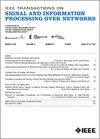Joint Multi-Ground-User Edge Caching Resource Allocation for Cache-Enabled High-Low-Altitude-Platforms Integrated Network
IF 3
3区 计算机科学
Q2 ENGINEERING, ELECTRICAL & ELECTRONIC
IEEE Transactions on Signal and Information Processing over Networks
Pub Date : 2023-09-14
DOI:10.1109/TSIPN.2023.3315597
引用次数: 1
Abstract
This article examines the cache-enabled high-low-altitude-platforms integrated network (CHLIN), which consists of multiple high-altitude platforms (HAPs) and cacheable low-altitude platforms (LAPs). CHLIN aims to leverage the edge caching, the flexibility of LAPs and the broad coverage and stability of HAPs to realize multi-ground-user content transmission. Considering the low endurance, dynamics, and limited storage capacity of LAPs, a combined optimization of content caching policies, offloading decisions, and HAP-servers and LAP-servers selection is designed to reduce the delay of content transmission while fulfilling users' demand for the quality of service. We transform the complex non-convex optimization problem with highly coupled variables into an equivalent convex problem. Afterward, a genetic-algorithm-embedded distributed alternating direction method of multipliers (GA-DADMM) is proposed, which adopts a distributed architecture for alternating iteration and introduces a genetic algorithm to derive the multi-dimensional and coupled local variables. Simulation results show that GA-DADMM achieves better convergence than the comparison algorithm, which is proper for large-scale optimization problems. The superiority of the proposed edge caching scheme in transmission delay reduction is also validated.基于缓存的高低空平台综合网络的多地面用户边缘联合缓存资源分配
本文研究了支持缓存的高低空平台集成网络(CHLIN),该网络由多个高空平台(HAP)和可缓存的低空平台(LAP)组成。CHLIN旨在利用边缘缓存、LAP的灵活性以及HAP的广泛覆盖和稳定性来实现多地面用户内容传输。考虑到LAP的低耐久性、动态性和有限的存储容量,设计了内容缓存策略、卸载决策以及HAP服务器和LAP服务器选择的组合优化,以减少内容传输的延迟,同时满足用户对服务质量的需求。将变量高度耦合的复杂非凸优化问题转化为等价凸问题。然后,提出了一种嵌入遗传算法的分布式交替方向乘法器方法(GA-DADMM),该方法采用分布式结构进行交替迭代,并引入遗传算法推导多维耦合局部变量。仿真结果表明,与比较算法相比,GA-DADMM算法具有更好的收敛性,适用于大规模优化问题。还验证了所提出的边缘缓存方案在减少传输延迟方面的优越性。
本文章由计算机程序翻译,如有差异,请以英文原文为准。
求助全文
约1分钟内获得全文
求助全文
来源期刊

IEEE Transactions on Signal and Information Processing over Networks
Computer Science-Computer Networks and Communications
CiteScore
5.80
自引率
12.50%
发文量
56
期刊介绍:
The IEEE Transactions on Signal and Information Processing over Networks publishes high-quality papers that extend the classical notions of processing of signals defined over vector spaces (e.g. time and space) to processing of signals and information (data) defined over networks, potentially dynamically varying. In signal processing over networks, the topology of the network may define structural relationships in the data, or may constrain processing of the data. Topics include distributed algorithms for filtering, detection, estimation, adaptation and learning, model selection, data fusion, and diffusion or evolution of information over such networks, and applications of distributed signal processing.
 求助内容:
求助内容: 应助结果提醒方式:
应助结果提醒方式:


